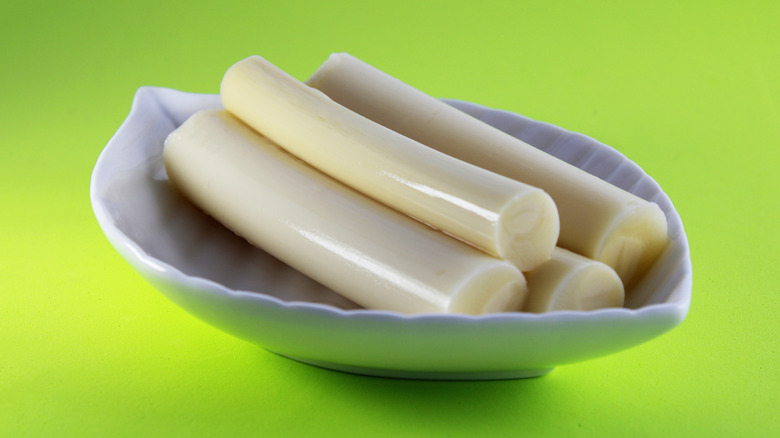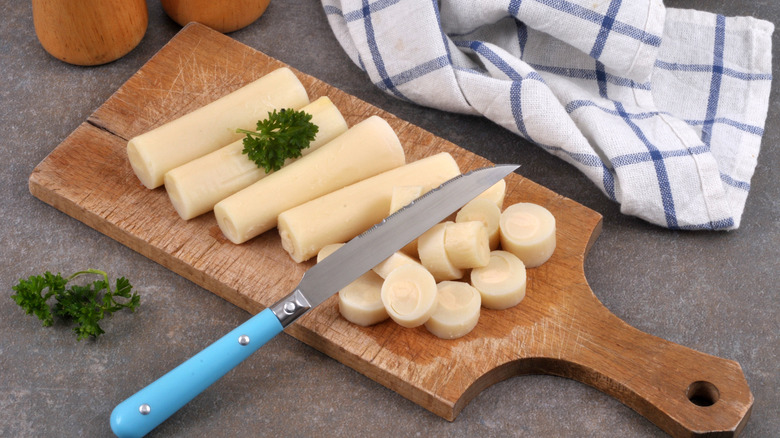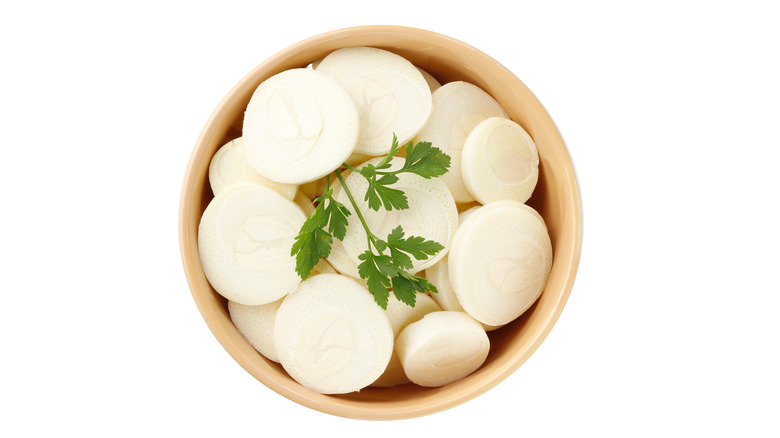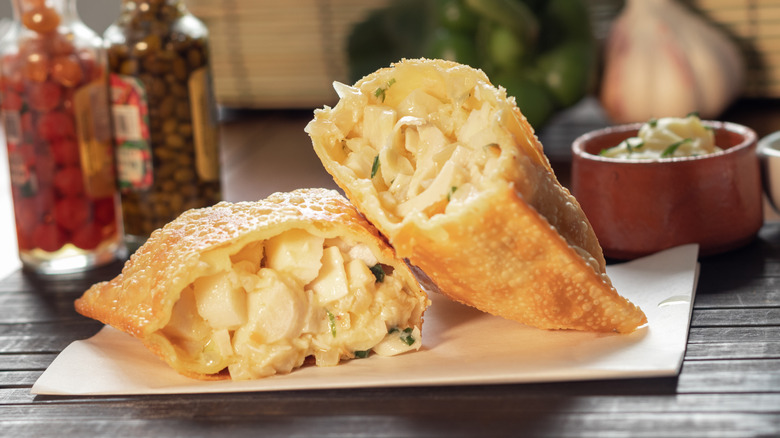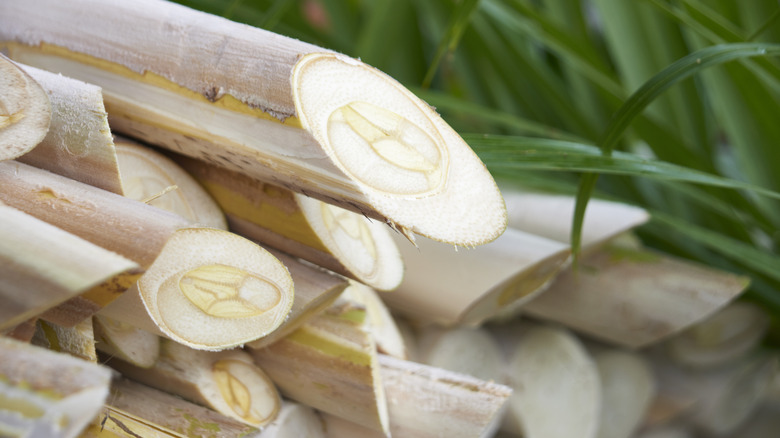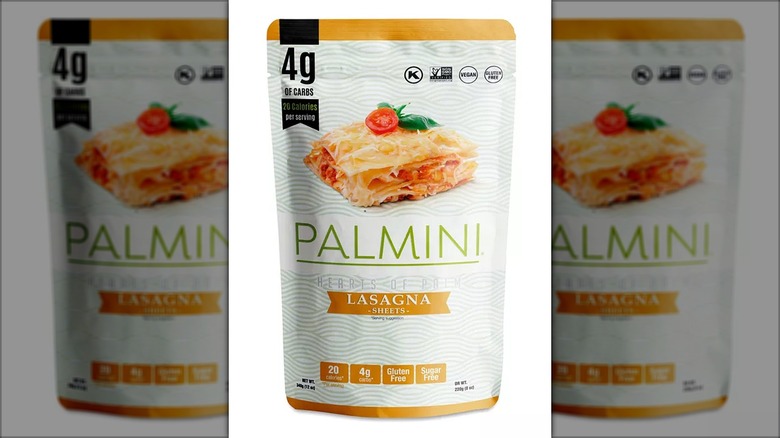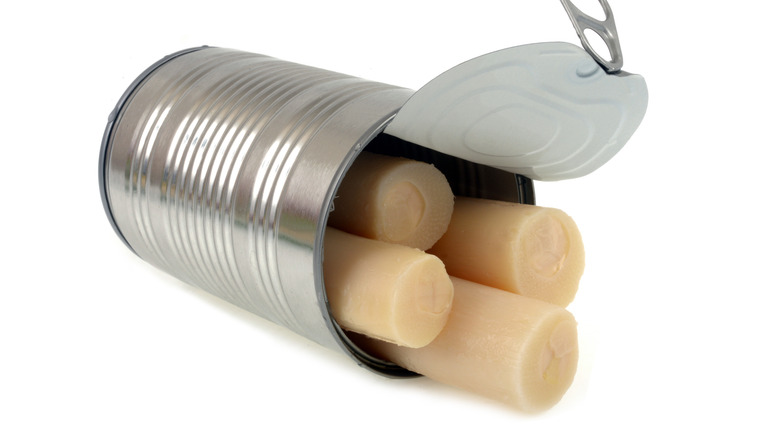A Beginner's Guide To Cooking And Eating Hearts Of Palm
If you have ever eaten from a restaurant salad bar, you have likely seen hearts of palm and perhaps have even tasted them without knowing what they are. Sometimes known as chonta, palmetto, swamp cabbage, palm cabbage, and millionaire's salad, these cylindrical white vegetables may seem exotic but are becoming more popular, particularly among those with vegetarian and gluten-free diets. And while they may seem like a recent addition to the culinary landscape, they have been a staple ingredient in the diets of ancient Mesoamericans for thousands of years.
These vegetables are convenient, versatile, and nutritious. When prepared correctly, they can be delicious in myriad ways. Find out where these unique edibles come from, how they are harvested, where you can purchase them, why you should be eating them, and, most importantly, how you can incorporate them into recipes in ways that will have you wondering why you were afraid to eat them in the first place.
What are hearts of palm?
As their name suggests, the hearts of palms are derived from the center of specific species of palm trees. The most common varieties are members of the peach palm or bactris gasipaes family native to Central and South America. These species of palm plants were first cultivated as a source of nutrition, fuel, and animal food by pre-Colombian people. The primary edible parts of this plant are the fruit, which is eaten cooked or fermented into alcohol, and the hearts of the palm.
Early iterations of hearts of palm relied on the use of single-stemmed palm trees, which eventually became over-harvested. These single-stemmed palms would perish once harvested, making them an unsustainable resource. Farmers today rely on multi-stemmed palm trees that can continue to grow even after a stem is harvested, making commercial hearts of palm a highly sustainable form of agriculture.
The stems get harvested once the tree is 18-30 months old and can continue to be harvested every 9-15 months. It is commonly harvested at one to two inches in diameter. Once the tree rind is removed and mulched, the remaining fibrous sheaths of the tree are peeled away and fed to livestock. When the tender heart is revealed, these are sold fresh or pickled. Most palm trees from which this delicacy is sourced for consumption in the U.S. are grown in Florida.
What do hearts of palm look like?
Peach palms are multi-stemmed trees that can grow to 19 to 78 feet in height and 4 to 26 inches in diameter. The stems, known as suckers, which are chosen for their centers, are usually on the younger and thinner side. The exterior of these trees is often adorned with dangerous thorns, though some commercial cultivars have been bred without thorns. The leaves of these trees are large and feather-like. These leaves are often used as natural dyes. The flowers are generally yellowish, and the oval rust-colored fruit are usually 2-3 inches long and 2-4 inches wide.
Once the hearts are prepared, they vaguely resemble a thick white asparagus on the outside. These cylindrical vegetables may be sold on the thin side when pickled, around one inch in diameter, or up to several inches if sold fresh. They are sold in segments ranging from 1 to 12 inches or sliced into roughly ½ inch pieces.
Pickled hearts of palm have an off-white hue, a somewhat juicy appearance, and are smooth on the exterior. Their center, when sliced, is punctuated by layer upon layer of slightly fibrous flesh ranging in width from a couple of millimeters to a centimeter. Fresh hearts of palm resemble jicama in color and texture, crisp yet moist when you slice into it.
What do hearts of palm taste like?
The flavor of hearts of palm is partly contingent on whether you are consuming them fresh or pickled. They are often said to resemble a cross between artichoke hearts and cooked white asparagus. We find this comparison overly simplistic. Their flavor is far more nuanced, and their texture has as much to do with this as anything else. This texture directly correlates to whether they are served fresh or canned.
When served in their fresh raw format, they tend to be crisper, with a more earthy vegetal flavor profile. When this is grilled or roasted, it develops a nutty, almost umami-rich flavor, which is why it is frequently used as a meat substitute in vegetarian recipes.
Once canned or pickled, the brining liquid transforms the flavor and texture into something more tender, milder, and slightly acidic. While a bit of that earthiness remains, the pickling process allows some natural sweetness to come forward.
Both raw and fresh hearts of palm are characterized by their capacity to absorb the flavors of other ingredients surrounding them. For this reason, they are a bit of a chameleon in the kitchen, which makes them highly desirable to chefs seeking to add more complexity to their recipes.
How to cook with hearts of palm
Cooking hearts of palm is another topic that can be approached differently depending on whether you use the fresh or canned variety. The firmer texture of the raw hearts of palm makes them ideal in myriad recipes as a meat or fish substitute. Like cauliflower, they can be roasted or grilled. They can also be shredded and used in salads, slaws, or relishes. They are also delightful when turned into fritters or cakes, similar to a latke or a mock crab cake.
Where canned hearts of palm are concerned, the sky is virtually the limit. While they are commonly used in salads, they are also perfectly incorporated into dips or marinated ceviche-style. Some more unusual recipes include adding them to pizza, breading and frying them, and using them in Asian-inspired stir-fries or fried rice dishes. Because they are like sponges, they take beautifully to spices, sauces, and dressings of all kinds, particularly ones that are acidic and rich in umami flavors.
For a twist on pasta, you can also obtain spaghetti noodles made with hearts of palm, which are shredded hearts of palm. These can be boiled and topped with sauces, like pesto or a marinara. They can also be turned into cold noodle dishes. And finally, try adding them to soups or ramen bowls for distinct texture and flavor.
Nutrition of hearts of palm
If their versatility in the kitchen wasn't enough to convince you to start adding hearts of palm to your culinary repertoire, their nutritional profile will. According to Healthline, hearts of palm is a low-calorie, nutrient-dense food. They are rife with minerals like potassium, phosphorus, copper, and zinc. There are also trace amounts of iron, calcium, magnesium, and folate.
Hearts of palm are also known to have high levels of polyphenol antioxidants, which have been linked to the neutralization of free radicals that can cause oxidative damage in your body associated with diseases like cancer, diabetes, and heart conditions. These antioxidants may also help to mitigate inflammation in the body.
Finally, as noted by WebMD, hearts of palm are one of the few plant-based foods containing all nine essential amino acids necessary to build and repair muscle tissue and maintain healthy bodily functions. These include histidine, isoleucine, leucine, lysine, methionine, phenylalanine, threonine, tryptophan, and valine. There is also anecdotal evidence that the vitamin B6 present in the hearts of palm may help pregnant women manage morning sickness.
Where to buy hearts of palm
Canned or jarred hearts of palm are available in virtually any grocery store and online through retailers. These may be your best bet for stocking up on this vegetable if you are factoring in convenience, cost, and a longer shelf-life.
If you want to try pasta made from hearts of palm, we have seen them in specialty grocery stores, including Trader Joe's, which has its store brand. Palmini is another more well-known brand available in several grocery stores and online. Palmini offers noodles, like spaghetti, linguine, and lasagna, rice varieties, and assorted mashed options. These come in vacuum-packed pouches and canned.
Lastly, if you are interested in obtaining fresh hearts of palm, there are a few online purveyors from which you can order it by the pound. You will want to note that raw hearts of palm are quite a bit more expensive, and you will have to pay the cost of shipping them overnight because they are so perishable. This can get quite pricey depending on how far they need to travel and what day of the week they are shipped.
How to store hearts of palm
Canned or jarred pickled hearts of palm in their original container will keep in a cool, dry place, away from sunlight indefinitely. These generally have a best-by date listed on the container, which indicates when the manufacturer believes they will have the best flavor. Like all canned goods, if you notice damage to the can, a foul odor, or a bulging can, you should discard canned hearts of palm.
Once canned hearts of palm are opened, transfer them to an airtight container or Ziploc bag. This can be kept in the refrigerator for three to four days or in the freezer for up to two months. Always be sure to note the freeze-by date on the package before storing your hearts of palm.
Fresh hearts of palm are a different matter. They only have a shelf-life of about 10 days in the refrigerator. They should be kept in airtight containers that cannot absorb strong odors. You could also freeze or pickle these for longer-term storage.
Hearts of palm pasta are generally shelf-stable, but you should refer to the individual packaging for storage instructions. These typically get stored the way you might keep other pasta, in an airtight container in a cool, dry place away from sunlight. The vacuum-sealed pouches and cans can be stored alongside other shelf-stable pantry items.
